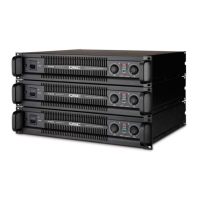14 QSC Audio Products, LLC
2.1 PL380 Circuit Description
The PL-380 uses an unregulated, open-loop switchmode power
supply that provides DC power to a pair of high-power Class D
amplifier channels. A master clock circuit synchronizes and
regulates the switching frequencies of all power supply and audio
amplification sections. Various input circuits, controls and displays,
protection systems, and output monitoring connect to the various
subsystems.
Power Supply
There are three distinct power supply domains in this amplifier.
• The main power supply provides ±185 volts at high current to
the main rails of the output section.
• The auxiliary power supply is derived from the main supply,
providing ±16-volt rails that are used by the cooling fan and
various low-voltage circuit blocks. Note that this supply tracks
the voltage and on/off status of the main supply.
• The "housekeeping" supply (labeled on the schematic as a
“keep-alive” supply) uses a separate low-power flyback system
to provide power to functions that need to be active during
standby.
The main power supply uses a large, center-tapped primary-side
reservoir capacitor bank (C209, C210, C213, C214, C216, and C217)
charged to DC voltages of about ±165 V by an offline (direct from
the AC mains) rectifier, BR1. The rectifier is wired as a voltage
doubler for 120 V AC operation, and as a full-wave bridge for 230 V,
and thus either configuration results in about the same DC voltage
on the reservoir.
The main switching devices, D68 and D69, are mounted along with
the rectifiers on one of the two smaller heat sinks and operate at a
frequency of 125 kHz to alternately couple the positive and negative
reservoir voltages (reference to the center tap of the reservoir, node
PRICAPCT) through T2:1, which are the primary windings of the
main power transformer, an E55-core isolation type. Capacitors
C231 and C232, together with the inductance of the primary, form a
series resonant tank that shapes the voltage waveform across the
primary into a pseudo-sinusoid instead of a square wave.
The transformer’s secondary voltages are rectified into a bank of
eight capacitors (Channel 1: C247–C250; Channel 2: C253, C254,
C259, and C260), which store nominal DC voltages of about ±185 V.
The secondary HF (fast) rectifiers D82–D85 are mounted on a
second, smaller heat sink.
The auxiliary supply uses single-turn taps on the main transformer
T2, with surface-mount rectifiers and small electrolytic capacitors,
to produce a bipolar pair of DC rails of approximately ±16 V.
The housekeeping flyback supply operates independently of the
high-power main supply, and powers certain circuit functions that
allow the main supply to operate.
Turn-On Sequence
The AC power switch spans points W17 and W18 and controls
power only to the housekeeping supply, which has a much smaller
DC reservoir (C190 and C191) than the main does. When switched
on, this supply starts in about a half second and provides secondary-
side DC power to the crystal-controlled clock circuit (U1, Y1, and
associated components) and main supply controller IC (U49),
resulting in 125 kHz drive to the main power supply switches.
After a short delay, the inrush-current relay, K2, closes and charges
the main supply’s reservoirs through large NTC resistors, R262 and
R266, which prevent drastic inrush current surges. During this time,
the primary and secondary reservoirs charge smoothly in unison
because the power supply switches are already operating. After
about one second, the main power relay, K1, closes and couples the
AC rectifiers directly to the primary reservoir, bypassing the inrush
resistors and providing full power. There is an additional 1-second
delay to allow all internal voltages to settle before the amplifier
comes out of muting.
Turn-off behavior
When power is removed, the amplifier mutes promptly, but the
power supply switches continue operating until primary and
secondary DC voltages have discharged to about 20%. There is an
OR-diode from the main reservoir to the housekeeping reservoir that
maintains voltage to the aux supply during this period. When this
DC voltage drops below about 45 V, the “housekeeping” supply
stops switching and the amp shuts off fully. This sequence of delays
and controlled inrush current will occur on all starts and restarts,
without causing adverse transients.
AC Cordsets
The 230 V version of the PL380 uses a 20 A/250 V rated Neutrik
Powercon® AC inlet, and the provided cordset uses 1.5 mm² × 3
wiring with a 16 A/250 V plug. The 120 V version uses a fixed 12/3
jacketed cable with a 30 A twist-lock plug. (We expect to use the
30 A 120 V PowerCon connector when it becomes available.)
Due to the high efficiency of Class D circuitry, there is a greater
difference between peak operating current and average operating
current at 1/8 of maximum power, so there is an extra margin of
current carrying capacity in the AC components.
Amplifier Channels
Each of the two amplifier channels uses two large switching FETs
operating as a half-bridge at a clock frequency of 250 kHz. The FETs
2. Technical Descriptions and Testing

